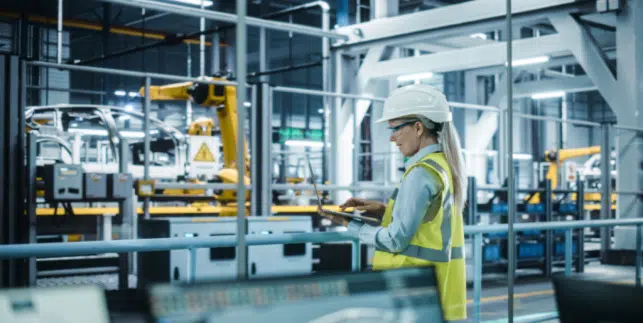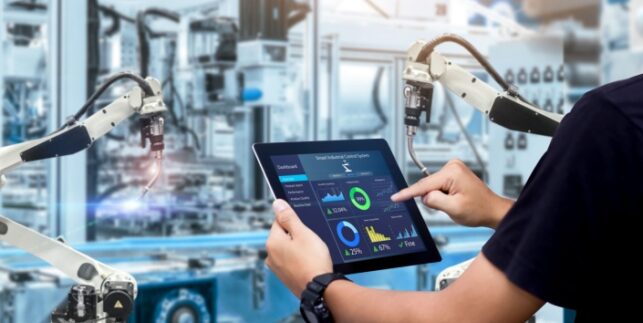Aggregate, Analyze, Act: How to Create a Balanced Shop Floor

Most manufacturers haven’t found the right balance for their shop floor yet. They find themselves dealing with misused resources, a lack of communication, inefficient workflows, and slow reactions to events as they happen. Matics provides a Real-time Operational Intelligence (RtOI) solution that addresses the three critical layers that make up a well-balanced shop floor.
These three layers are aggregate, analyze, and act.
RtOI aggregates data from multiple sources, analyzes that data to extract meaningful insights, and puts those insights into action through work management and automation tools. Each layer builds on those beneath it, coming together to form a comprehensive solution that provides visibility into your manufacturing operations.
The end result for manufacturers is improved workflows, reduced costs, increased efficiency, and further operational benefits. To better understand how RtOI provides these benefits, let’s go through the three layers in more detail.
Layer 1: Multi-Source Data Aggregation
The first step involved in RtOI is data aggregation. Most manufacturers will find that they’re leaving significant amounts of valuable production data uncollected or unused. A thorough review of available data and a plan to capture this data ensures that you will have the information that you need, opening the door to the full benefits that RtOI can provide.
At the most basic level, this means having all machines and sensors connected to the system for fully automated data collection. Instead of relying on operators with clipboards and logbooks to take measurements manually, manufacturers can save time and improve accuracy through automated data collection.
However, aggregation goes further than this. RtOI works with all existing information systems to create a holistic overview of the state of the shop-floor. Data can be aggregated from any information system, including existing MES and ERP, procurement solutions, inventory solutions, and more.
This also includes collecting data from human experts within the organization. While data collection automation can do away with the time spent reading numbers off of gauges and displays, there’s always a need to make the most effective use of valuable human knowledge and experience within the company.
Data aggregation is the first layer, so drawing information from as many relevant sources as possible serves to lay the best possible foundation for the next steps. Manufacturers can’t act on information that is never collected in the first place.
Multi-source aggregation also provides the benefit of having all useful information compiled in a single source of truth. Manufacturers often capture data from different sources in different systems or networks or even paper records. This stifles efficiency and collaboration across the organization.
Possibly more important than any other benefit, automated aggregation can ensure that production data is collected and made accessible in real-time. Conventional methods often rely on shift-end reports or waiting on operators to physically enter data from one system to another. Sometimes this can happen long after the fact – end of shift, end of day, or even month-end. Instead, the data aggregation layer of RtOI allows for production data on what’s happening at that moment.
While manufacturers might have been able to ignore the importance of multi-source data aggregation in the past, that isn’t the case today. Industry 4.0 and IoT advancements have created a wealth of opportunities for improved aggregation, and manufacturers must act to remain competitive.
Uncollected, misplaced, or inaccurate data leads to inefficiency and missed opportunities for manufacturers. By ensuring that this crucial first layer is handled properly, RtOI can avoid this and provide manufacturers with the widest possible range of benefits.
Layer 2: Real-time, Continuous Analytics & Insights
Data aggregation creates a solid foundation, but that step alone doesn’t provide the full benefits that RtOI has to offer. Accurate production data that can be accessed easily and reliably is valuable in itself, but RtOI goes beyond that with the second layer – real-time analytics and insights.
Much of the power of RtOI comes from the fact that it provides continuous analysis in real-time. In this environment, production data isn’t reviewed after the fact to draw recommendations for next time; It is used immediately to develop actionable insights that can be used to impact the results of the shift. The underlying tools and systems run continuously, making it possible to take advantage of the full benefits of the aggregated production data.
These analytical tools can provide a wide range of insights. At the most basic level, they allow manufacturers to know immediately when KPIs drift outside their thresholds. Where an operator can watch a few KPIs at set time intervals, real-time analytics does so continuously to reduce the time between an event and its discovery as much as possible.
Simply having a system monitoring KPIs and other parameters at all times is a considerable asset, but real-time analytics can go beyond this. With powerful algorithms and metrics, RtOI identifies trends and events that would have evaded even the smartest and most attentive operators.
RtOI also incorporates historical production data into its real-time analytics, becoming more capable of identifying the trends that indicate deviating processes and KPIs at risk of crossing thresholds. RtOI is a true Industry 4.0 capability that lets manufacturers leverage the full advantages of real-time analytics.
Beyond simply identifying meaningful insights, RtOI also communicates them effectively. More than a simple alarm or alert, RtOI takes insights and delivers them in an actionable format. Insights are communicated to the right stakeholders, decision-ready, and with the context needed to act immediately.
The link between the system’s real-time analytics and the people receiving its insights is carefully developed to suit individual roles throughout a manufacturing organization. A variety of apps are used for managers, operators, technicians, and more to ensure that they have the best access to the information and insights most relevant to their roles.
Production data carries valuable information, and real-time analytics makes it possible to extract insights faster, more efficiently, and more thoroughly than ever before. With RtOI, the benefits offered by real-time analytics can be fully realized on the shop floor.
Layer 3: Work Management & Automation Tools
Data aggregation and real-time analytics serve to ensure that production data is being used to provide valuable insights. Through work management and automation tools, these insights can become more than simple recommendations and instead serve as a driving force for everything that happens on the shop floor.
Real-time alerts are a fundamental tool that serves to translate insights into action. As the system identifies issues or opportunities for improvement, the appropriate stakeholders can be notified immediately. With RtOI, manufacturers are able to develop real-time alerts tied to a variety of trigger events, thresholds, and KPIs.
Manufacturers can build on the foundation provided by real-time alerts with rule allocations. Instead of simply providing an alert in response to a trigger, manufacturers can set automated workflows that immediately enact the appropriate service calls, messages, and other tasks to resolve the issue. Both alerts and rule allocation serve to reduce the latency between events happening and action taking place.
The advantages of these tools aren’t limited to when something goes wrong. With the task management tools that RtOI offers, manufacturers can remotely assign and manage tasks to different stakeholders on the shop floor. Tasks can be monitored in real-time, with important insights into progress and targets.
Further insights into task management let manufacturers improve over time, plan maintenance, and optimize processes. Insights can reveal trends in the productivity of specific machines, shifts, operators, and other factors to highlight issues and opportunities for improvement.
Throughout the industry, manufacturers are adopting Industry 4.0 capabilities that let them make better use of production data. However, RtOI provides work management and automation tools that let manufacturers take even great advantage of a modern and connected shop floor. The continuous improvement capabilities, reduced costs, and improved productivity that these tools provide give manufacturers a competitive edge in this rapidly changing industry.

Changing the way people work in factories
Request a DemoA Comprehensive Approach With RtOI
RtOI lets manufacturers aggregate, analyze, and act to create a balanced shop floor and achieve the productivity and efficiency benefits that come with it. It does so by getting each of the three layers right and building on the benefits of each to deliver even greater advantages for manufacturers. You can contact Matics today for more about RtOI and how it can transform your shop floor.




